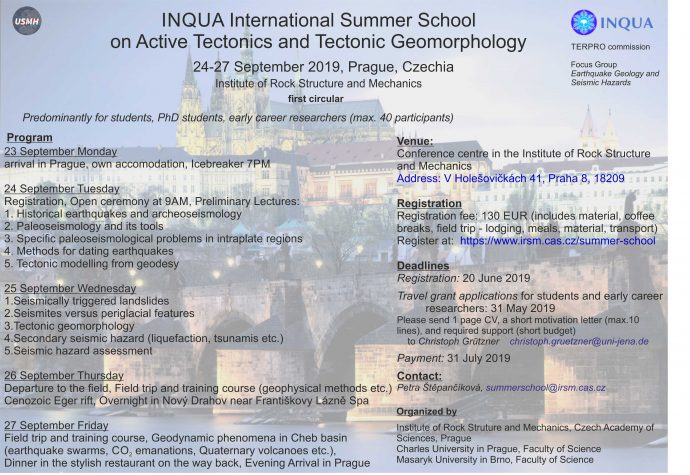New month, new papers! This time we have a lot of studies on tectonic geomorphology and landscape evolution, and new insights from Italy and New Zealand, among others. These are the latest papers, enjoy reading!
-
New papers on paleoseismology, earthquakes, and active tectonics (May 2019)
-
The 17th International Symposium on Geo-disaster Reduction
2019-04-25 | in EventsStill looking for a cool conference to attend this summer? Why not travel to Kyrgyzstan for the 17th International Symposium on Geo-disaster Reduction from 19-23 August 2019, organized by our friend Hans-Balder Havenith with Liège University, the Kyrgyz Institute of Seismology and Institute of Geomechanics and Mining, and the International Consortium on Geo-disaster Reduction (ICGdR)? more
-
Open positions in tectonics and related fields
-
1st circular: INQUA Int’l Summer School on Active Tectonics & Tectonic Geomorphology in Prague, 24-27 September 2019
The INQUA Focus Group on Earthquake Geology and Seismic Hazards (EGSHaz) will run the International Summer School on Active Tectonics and Tectonic Geomorphology in Prague from 24-27 September, 2019. This event replaces the PATA Days this year and aims mainly at MSc./PhD students and Early Career Researchers. Please note that this is not a classical PATA Days event where new science will be shown and discussed. The summer school is organized by the Institute of Rock Structure and Mechanics, Czech Academy of Sciences and the Charles University in Prague, Faculty of Science. Please find a pdf of the first circular here.

-
Christoph Grützner
New papers on paleoseismology, earthquakes, and active tectonics (April 2019)
-
Deadlines for the IAS Rome Congress – session on the sedimentary record of earthquakes, tsunamis and other extreme/catastrophic events
2019-03-26 | in MeetingThe deadline for the submission of abstracts to the 34th IAS Congress of Rome 2019 is approaching (30 March 2019). The 34th IAS meeting will be held in Rome from 10-13th September 2019 (http://iasroma2019.org/).
There will be lots of interesting sessions, of special interest for the earthquake geology community will be session 7.11 The Sedimentary Record of Earthquakes, Tsunamis and other Extreme/Catastrophic Events.
Conveners:
- Massimo Moretti (University of Bari Aldo Moro, Italy)
- Jasper Knight (Wits University, South Africa)
- Giuseppe Mastronuzzi (University of Bari Aldo Moro, Italy)
- Andreas Vött (Mainz University, Germany)
-
New papers on paleoseismology, earthquakes, and active tectonics (March 2019)
-
US Bursaries to attend the INQUA congress in Dublin
2019-02-25 | in MeetingThe INQUA Congress in Dublin will be the event for Quaternary science this year, but Dublin is quite expensive and many ECRs will need travel support. While the application deadline for the INQUA grants has already passed, there is still an option for early career scientists from the US to get up to US$ 2,000. See the INQUA Dublin website for details and make sure to not miss the deadline March 15, 2019.
-
Postdoc position at Oxford University: Palaeoseismology of Central Asian Earthquake Ruptures
2019-02-22 | in Field work, Jobs | one responseThere is a wonderful, amazing, extraordinary postdoc position open at Oxford University: Palaeoseismology of Central Asian Earthquake Ruptures.
We seek to appoint a postdoctoral research assistant to undertake investigations of large earthquakes within the interior of Asia. The post is part of a project funded by the Leverhulme Trust called EROICA. The successful candidate will work closely with Professor Richard Walker, and will join a vibrant community of active tectonics researchers in Oxford within the Earthquake Geology and Geodesy group.
The researcher will be responsible for the detailed mapping of palaeo-earthquake ruptures, the construction of slip distributions from individual earthquakes, the analysis of high-resolution satellite imagery, the construction of digital topographic models, and the selection of sites for long-term slip-rate determination using field investigation. The PDRA will also be involved in planning and carrying out fieldwork to verify remote-sensing observations, to collect samples for dating, and to excavate and interpret palaeo-seismic trenches. We expect the researcher to help in supervising doctoral and masters student research projects, in addition to undertaking their own research.
-
7th International Colloquium on Historical Earthquakes & Paleoseismology Studies, 4-6 Nov 2019, Barcelona
2019-02-19 | in MeetingThe 7th International Colloquium on Historical Earthquakes & Paleoseismology Studies will be held from 4-6 November, 2019, in Barcelona (Spain). The conference website is now online (https://cloud.agoraevent.fr/Site/134404/5997/Event).
Important dates:
15 February 2019: Opening for submission for abstracts
15 September 2019: Deadline for submission of abstracts
